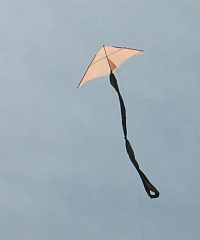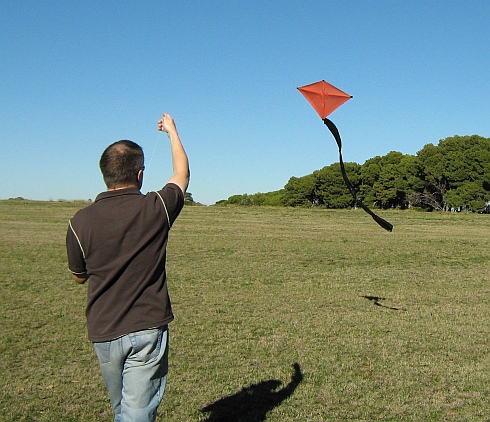- Home Page
- Kite Plans
- Cheap Kites
Cheap Kites
Material Costs for MBK Skewer Kites
MBK Skewer Series designs are indeed very cheap kites to make! Just for fun, I thought I would demonstrate this.
Even the much bigger Dowel Series designs only set you back a few dollars per kite.
But the Skewer Series designs are spectacularly cheap, as you will see from these figures compiled in late 2008. OK, so they might be a little outdated, but you'll get the general idea about the rock bottom costs involved.
The first step was to visit the local stores where the original materials were bought, and note down some prices.
 MBK 1-Skewer Delta
MBK 1-Skewer DeltaOf course, prices shift around from week to week, and also from store to store for the same product. However, the Australian Dollars figures below should be approximately correct, even now in 2012. Even the equivalent prices for US products should be in the same ballpark.
The cost of flying line is not included, since we use just two or three lines shared between all our kites. However, in this day and age of light but strong polyester sewing thread, flying line for these rather small kites need not be expensive at all. Heavier than average grades, like bobbin thread, would be required for the 2-Skewer designs however.
With generic brand products available, some of these items can vary a lot in price, but I have gone for the cheapest in every case. That usually meant the generic brand, if available. Some were on Special too, but in those situations I used the original price. That was so the final figures for these cheap kites were as realistic as possible.
On this site, there's more kite-making info than you can poke a stick at. :-)
Want to know the most convenient way of using it all?
The Big MBK E-book Bundle is a collection of downloads—printable PDF files which provide step-by-step instructions for many kites large and small.
That's every kite in every MBK series.
The Materials Unit Price
From the supermarket price for each item, a unit price was calculated. This figure makes it easy to estimate what any given kite actually costs to make.
Have you ever made cheap kites in a workshop for kids or interested adults? If so, note that the more plastic kites that are made, the more accurate these costings will be since a bigger percentage of the bought material will be used up. Even if all the info here is not entirely relevant to your own situation, you might like to go through a similar process one day when costing your own kite making activities. For instance, if you live in the USA, there will be differences in all the products and prices.
Item
Price
Unit Price
bag of 100 bamboo skewers, 30 cm
$1.40
1.4 cents per skewer
bag of 40 large freezer bags
$0.70
1.8 cents per bag
50 black garbage bags
$5.46
11 cents per bag
10 orange garden bags
$2.05
21 cents per bag
3 rolls clear sticky tape, 33 meters each
$2.00
0.02 cents per cm
6 roll pack of electrical tape, 7.5 meters each
$2.29
0.51 cents per cm
250 ml Aquadhere PVC glue
$5.60
2.2 cents per ml
The above table was compiled mainly from info gleaned from the shelves of a local supermarket and variety store here in Adelaide, South Australia.
VERY Cheap Kites!
Here's proof, in the form of total cost for every kite made so far—and a couple that I hadn't even got to making at the time of this writing!
Just before I list the numbers, I thought it might be useful to show a detailed costing, to show the process. Cheap kites don't come much more inexpensive than the 1-Skewer Diamond Kite. It's pretty small and simple.
1-Skewer Diamond Kite Costing
Sail: Two sails can be made from one large freezer bag. Unit price for the bags is 1.8 cents per bag, so one sail costs 1.8 / 2 = 0.9 cents.
Reinforcement: All together, about 95 cm of sticky tape are needed to secure the sail to the spar ends, and reinforce the sail edges. Unit cost is 0.02 cents per cm, so all up cost for tape is 95 x 0.02 = 1.9 cents.
Spars: Two bamboo skewers are required. Unit price for skewers is 1.4 cents per skewer, so two skewers cost 1.4 x 2 = 2.8 cents.
Spar Attachment: Let's assume 0.1 ml of glue is used to fix the spars together where they cross. Unit price is 2.2 cents per ml, so that's 2.2 / 10 = 0.2 cents.
Tail: A single bag is used for all the loops in the tail. So that's 1.8 cents.
So, one of these nifty little diamond kites will set you back a total of 0.9+2.8+1.9+1.8+0.2 = 7.6 CENTS. Isn't that amazing! Even if you took no care with prices, the MBK 1-Skewer Diamond would probably still come in at less than 30 cents. Talk about cheap kites!
In a similar way, I have costed all the other MBK kites in both the 1 and 2-Skewer Series. Here are the results, from cheapest to most expensive (!), rounded to the nearest cent:
MBK Kite
Materials Price (cents!)
1-Skewer Diamond
8
1-Skewer Barn Door
9
1-Skewer Sled
11
1-Skewer Rokkaku
11
1-Skewer Sode
12
1-Skewer Roller
12
1-Skewer Delta
15
1-Skewer Dopero
15
2-Skewer Diamond
33
2-Skewer Rokkaku
38
2-Skewer Delta
42
2-Skewer Sled
45
2-Skewer Barn Door
46
2-Skewer Sode
49
2-Skewer Roller
67
2-Skewer Dopero
77
 Launching the original MBK 2-Skewer Diamond
Launching the original MBK 2-Skewer DiamondSome notes on those results:
For practical purposes, there's no point in calculating the sail area of each kite precisely. That's because you can't use all the offcuts can you! So, the cost is based on how many sails you can get from a single bag.
If you are super stingy you might find ways to use all the offcut material! If nothing else, it would leave you with the warm feeling that absolutely nothing has been wasted in making your cheap kites :-)
In fact, here's an idea: Cut the offcuts into odd shapes, and then tie them at regular intervals along a long narrow ribbon. The ribbon could be cut from another bag of the same material. Fluttering around in the air, this tail wouldn't look that much different from one done with perfectly rectangular cross-pieces.
The photo shows me launching the original 2-Skewer Diamond kite. It was a good reliable flyer.
As mentioned earlier, there's more kite making on this site than you can poke a stick at. :-)
Want to know the most convenient way of using it all?
The Big MBK E-book Bundle is a collection of downloads—printable PDF files which provide step-by-step instructions for many kites large and small.
That's every kite in every MBK series.
